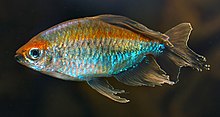Congo tetra
| Congo tetra | |
|---|---|

| |
| Scientific classification | |
| Domain: | Eukaryota |
| Kingdom: | Animalia |
| Phylum: | Chordata |
| Class: | Actinopterygii |
| Order: | Characiformes |
| Family: | Alestidae |
| Genus: | Phenacogrammus |
| Species: | P. interruptus
|
| Binomial name | |
| Phenacogrammus interruptus (Boulenger, 1899)
| |
The Congo tetra (Phenacogrammus interruptus) is a species of fish in the African tetra family, found in the central Congo River Basin in Africa. It is commonly kept in aquaria.
Description[edit]
This section includes a list of references, related reading, or external links, but its sources remain unclear because it lacks inline citations. (February 2021) |
The Congo tetra has a typical full-bodied tetra shape with rather large scales. When mature, the iridescent colors of the Congo tetra run through the fish from front to back, starting with blue on top changing to red through the middle, to yellow-gold, and back to blue just above the belly. It is not its fluorescent colors that make this tetra so distinct, but rather its tail fin, which develops into a grayish-violet feathery appendage with white edges. The males get up to 3.0 inches (8.5 cm). Females up to 2.75 inches (6 cm). The male is larger with more color, also the tail fin and dorsal fin are more extended.[2] They also have different colors and extensions in the caudal fin.
Aquarium trade and keeping[edit]

Congo tetra are a popular aquarium species. However, their large size and active behavior makes them unsuited for most smaller tanks. They easily adapt to captive diets like pellets and frozen foods, though they will still hunt down live foods when offered. They have successfully been bred in captivity and captive bred individuals are commonly available. Whilst they can be kept healthy on a slightly wider range of water parameters, breeding often requires water parameters more similar to their natural habitat. Bad water quality has been known to affect male fin development and lead to loss of coloration.[3]
Disease and Care[edit]
The Congo Tetra is a moderately hardy freshwater fish. This species thrives in a well-maintained aquarium that mimics its natural, slightly acidic and soft-water habitat. Optimal health for Congo Tetras is achieved in a stable environment with good water quality, a balanced pH level of around 6.0 to 7.5, and temperatures between 72°F and 82°F. A varied diet, including quality flake food, frozen or live brine shrimp, and bloodworms, is essential for maintaining their vibrant colors and overall vitality.
Common diseases affecting Congo Tetras include Ichthyophthirius multifiliis (Ich), a parasitic infection manifesting as white spots on the body and fins, and fin rot, often due to poor water quality. Preventive care is key, emphasizing regular water changes, tank cleanliness, and avoiding overfeeding. Quarantining new fish before introducing them to the main tank is crucial to prevent the spread of diseases. In case of illness, early detection and treatment, often involving specific medications and improved tank conditions, are vital for recovery.[3] Proper care and attention to their environmental needs ensure these stunning fish remain a healthy and dynamic part of any aquarium community.
Conservation status[edit]
The IUCN lists the Congo tetra as a species of Least Concern.
See also[edit]
Sources[edit]
- Ultrastructural Examination of Spermiogenesis and Spermatozoon Ultrastructure in Congo tetra Phenacogrammus interruptus Boulenger, 1899 (Ostariophysi: Characiformes: Alestidae)
- Author: Pecio, Anna
- Folia Biologica, Volume 57, Numbers 1–2, December 2008, pp. 13–21(9)
- Publisher: Institute of Systematics and Evolution of Animals, Polish Academy of Sciences
References[edit]
- ^ Snoeks, J.; Laleye, P.; Moelants, T.; Contreras-MacBeath, T. (2010). "Phenacogrammus interruptus". IUCN Red List of Threatened Species. 2010: e.T167968A6428241. doi:10.2305/IUCN.UK.2010-3.RLTS.T167968A6428241.en. Retrieved 19 November 2021.
- ^ a b "Search Results". www.iucnredlist.org. Archived from the original on 2009-11-06.
- ^ a b "Phenacogrammus interruptus (Congo Tetra) — Seriously Fish".
External links[edit]
 Media related to Phenacogrammus interruptus at Wikimedia Commons
Media related to Phenacogrammus interruptus at Wikimedia Commons- Fishbase
- Congo Tetra Fact Sheet

